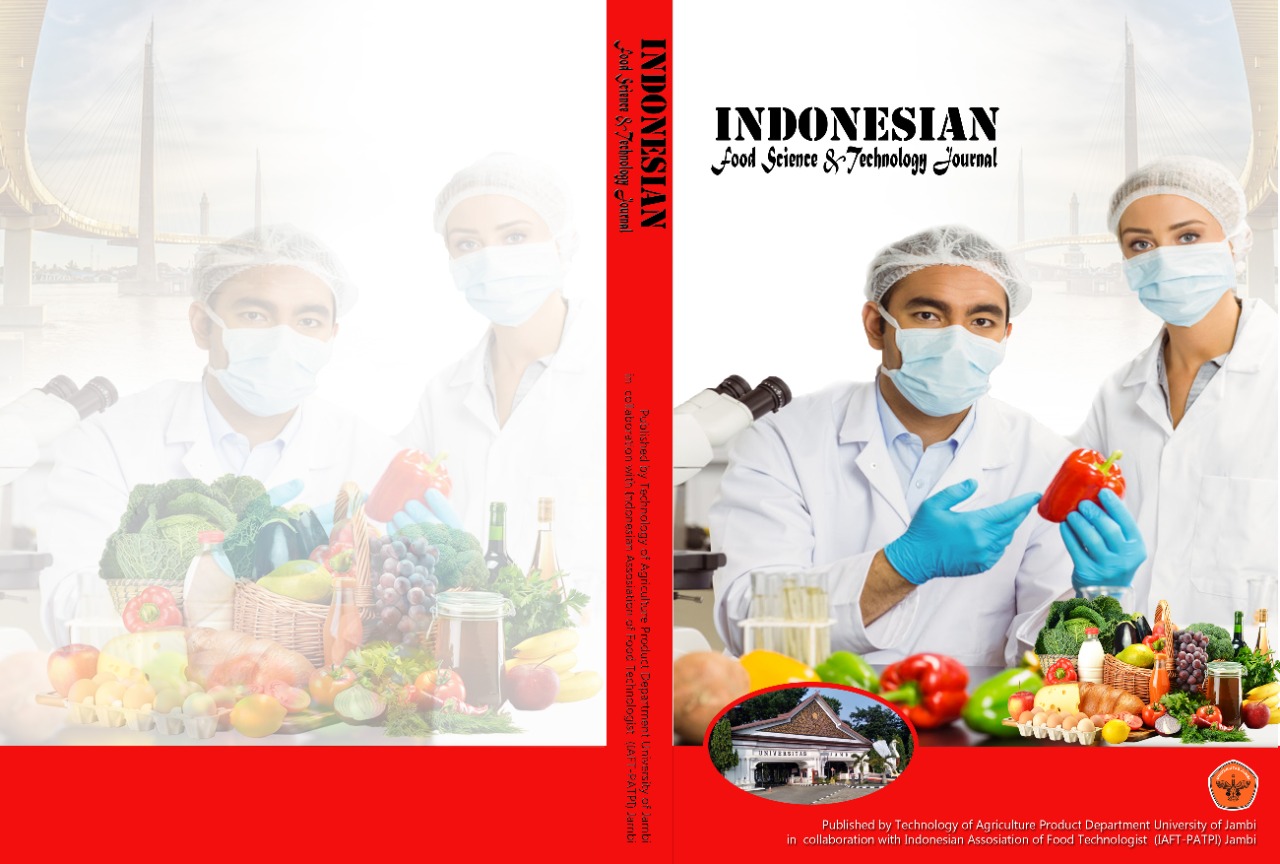Dextrose Equivalent (DE) Variation and Maltodextrin Concentration Effects in Yoghurt Powder Characteristics Using Foam-mat Drying
DOI:
https://doi.org/10.22437/ifstj.v7i1.30152Keywords:
DE Value, Maltodextrin, Yoghurt, Lactic Acid BacteriaAbstract
Lactic Acid Bacteria (LAB) in yoghurt is a probiotic bacteria which potentially improves intestinal health. Yoghurt has a high moisture content. Thus, storing it at low temperatures can maintain the stability of microbes in the yoghurt. Yoghurt stored in the refrigerator has a maximum shelf life of 10 days. Yoghurt powder is one of the alternative solutions to prolong the shelf life. This study used a randomized design of factorial groups with variations of dextrose equivalent (DE) values of 10-12 and 18-20, as well as variations of maltodextrin concentrations of 10, 15, and 20%. The study aimed to determine the DE value and maltodextrin concentration which can produce the best quality synbiotic yoghurt powder. The quality of this synbiotic yoghurt was assessed by the highest yield, lowest water content, highest solubility, highest water absorption, highest acidic titrated total, highest total of lactic acid bacteria, and highest organoleptic. The study obtained that the DE value of maltodextrin affected the total LAB. Meanwhile, the concentration of maltodextrin affected the yield, moisture content, solubility, acidic titrated total, and total of LAB. The interaction between the DE value and the concentration of maltodextrin did not affect all the parameters of this study.
Downloads
References
M. V. Pratana, V. I. Meitiniarti, and A. B. A. Sukmana, “Uji viabilitas bakteri asam laktat dalam enkapsulasi menggunakan alginat dan susu skim secara kering dingin,†in Peningkatan Kualitas Publikasi Ilmiah melalui Hasil Riset dan Pengabdian kepada Masyarakat, Jakarta: Institute for Research and Community Services (LPPM) Universitas Indraprasta PGRI, Nov. 2019, pp. 484–495.
D. H. Rahman, I. Tanziha, and S. Usmiati, “Formulasi produk susu fermentasi kering dengan penambahan bakteri probiotik Lactobacillus Casei dan Bifidobacterium Longum.,†Indonesian Journal of Nutrition and Food, vol. 7, no. 1, pp. 49–56, 2012.
A. Febrianto, S. Kumalaningsih, and A. Windi Aswari, “Process engineering of drying milk powder with foam mat drying method: A study of the effect of the concentration and types of filler,†Journal of Basic and Applied Scientific Research, vol. 2, no. 4, pp. 3588–3592, 2012.
Association of Official Analytical Chemyst [AOAC], “Official method of analysis of the association of official analytical of chemist,†Virginia, 2005.
B. Koc, M. S. Yilmazer, P. Balkır, and F. K. Ertekin, “Spray drying of yoghurt: optimization of process conditions for improving viability and other quality attributes,†Drying Technology, vol. 28, no. 4, pp. 495–507, Mar. 2010, doi: 10.1080/07373931003613809.
I. R. Hidayat, Kusrahayu, and S. Mulyani, “Total bakteri asam laktat, nilai pH dan sifat organoleptik drink yoghurt dari susu sapi yang diperkaya dengan ekstrak buah mangga,†Animal Agriculture Journal, vol. 2, no. 1, pp. 160–167, 2013.
M. Abdi, “Pengaruh penambahan maltodekstrin dan lama pengeringan terhadap yoghurt bubuk biji nangka (Artocarpus Heterophyllus Lamk),†Doctoral Dissertation, Universitas Muhammadiyah Sumatera Utara, Medan, 2018.
W. Hersoelistyorini, S. S. Dewi, and A. C. Kumoro, “Sifat fisikokimia dan organoleptik tepung mocaf dengan fermentasi menggunakan ekstrak kubis,†in Teknologi Kimia dan Industri, Semarang: LPPM UNIMUS, 2015, pp. 246–256.
D. Purbasari, “Aplikasi metode foam-mat drying dalam pembuatan bubuk susu kedelai instan,†Jurnal Agroteknologi, vol. 13, no. 1, pp. 52–61, 2019.
M. F. Yana and J. Kusnadi, “Pembuatan yogurt berbasis kacang tunggak (Vigna unguiculata) dengan metode freeze drying (kajian jenis dan konsentrasi bahan pengisi),†Jurnal Pangan dan Agroindustri, vol. 3, no. 3, Oct. 2014, [Online]. Available: https://jpa.ub.ac.id/index.php/jpa/article/view/243
Miskiyah, Juniawati, K. Ayu, and A. H. Mulyati, “Study on yoghurt powder probiotic quality using foam-mat drying method,†IOP Conf Ser Earth Environ Sci, vol. 309, pp. 1–7, Sep. 2019, doi: 10.1088/1755-1315/309/1/012048.
A. Masykur and J. Kusnadi, “Karakteristik kimia dan mikrobiologi yoghurt bubuk kacang tunggak (Vigna Unguiculata L.) metode pengeringan beku (kajian penambahan starter dan desktrin),†Jurnal Pangan dan Agroindustri, vol. 3, no. 3, pp. 1171–1179, 2015.
M. Djali, R. Indiarto, and V. Avila, “Kajian penggunaan maltodekstrin pada pembuatan soyghurt bubuk dengan metode pengeringan beku,†Jurnal Penelitian Pangan (Indonesian Journal of Food Research), vol. 2, no. 1, Feb. 2018, doi: 10.24198/jp2.2017.vol2.1.02.
M. Djali, H. Marta, and S. Harnah, “Characterics of freeze-dried jack bean yogurt powder with maltodextrin as coating material,†Jurnal Penelitian Pascapanen Pertanian, vol. 13, no. 1, p. 28, Aug. 2017, doi: 10.21082/jpasca.v13n1.2016.28-35.
U. R. Ernawati, L. U. Khasanah, and R. B. K. Anandito, “Pengaruh variasi nilai Dextrose Equivalents (DE) maltodekstrin terhadap karakteristik mikroenkapsulan pewarna alami daun jati (Tectona Grandis L.F.),†Jurnal Teknologi Pertanian, vol. 15, no. 2, pp. 111–120, 2014.
C. E. Endriyani, “Kajian karakteristik fisiko kimia dan sensori mikroenkapsulan ekstrak tempe bosok terstandar sebagai food seasoning dengan variasi rasio enkapsulan gum arab dan maltodekstrin,†Undergraduate Thesis, Universitas Sebelas Maret, Surakarta, 2012.
W. Kania, MA. M. Andriani, and Siswanti, “Pengaruh variasi rasio bahan pengikat terhadap karakteristik fisik dan kimia granul minuman fungsional instan kecambah kacang komak (Lablab Purpureus (L.) Sweet),†Jurnal Teknosains Pangan, vol. 4, no. 3, pp. 16–29, 2015.
D. M. Sumanti, I. Lanti, I.-I. Hanidah, E. Sukarminah, and A. Giovanni, “Pengaruh konsentrasi susu skim dan maltodekstrin sebagai penyalut terhadap viabilitas dan karakteristik mikroenkapsulasi suspensi bakteri lactobacillus plantarum menggunakan metode freeze drying,†Jurnal Penelitian Pangan (Indonesian Journal of Food Research), vol. 1, no. 1, pp. 7–13, Aug. 2016, doi: 10.24198/jp2.2016.vol1.1.02.
M. Masyhura, M. Faudi, and S. Surnaherman, “Aplikasi maltodekstrin pada pembuatan yogurt bubuk biji nangka (arthocarpus lineus),†Jurnal Teknologi Pertanian Andalas, vol. 25, no. 1, p. 73, Mar. 2021, doi: 10.25077/jtpa.25.1.73-80.2021.
S. R. Tias, “Kajian karakteristik bumbu kuah bakso bubuk dengan penambahan maltodekstrin menggunakan metode pengeringan vakum ,†Universitas Padjadjaran, Bandung, 2013.
Yi Shui Dadi Corn Development, “Certificate of Analysis Maltodextrin.,†China, 2015.
M. M Tahir, J. Langkong, A. B. Tawali, N. Abdullah, and S. Surahman, “Study Effect Dryer and Concentration of Maltodextrin to Drink Tea Products–Sappan Wood Effervescent,†Canrea Journal: Food Technology, Nutritions, and Culinary Journal, vol. 2, no. 1, pp. 51–61, 2019, https://doi.org/10.20956/canrea.v2i1.192
Downloads
Published
How to Cite
Issue
Section
License
Copyright (c) 2023 Indonesian Food Science and Technology Journal

This work is licensed under a Creative Commons Attribution 4.0 International License.







